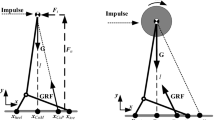Abstract
In order to obtain new insight into the control of balance during arm raising movements in bipedal stance, we performed a biomechanical analysis of kinematics and dynamical aspects of arm raising movements by combining experimental work, large-scale models of the body, and techniques simulating human behavior. A comparison between experimental and simulated joint kinematics showed that the minimum torque change model yielded realistic trajectories. We then performed an analysis based on computer simulations. Since keeping the center of pressure (CoP) and the projection of the center of mass (CoM) inside the support area is essential for equilibrium, we modeled an arm raising movement where displacement of one or the other variable is limited. For this optimization model, the effects of adding equilibrium constraints on movement trajectories were investigated. The results show that: (a) the choice of the regulated variable influences the strategy adopted by the system and (b) the system was not able to regulate the CoM for very fast movements without compromising its balance. Consequently, we suggest that the system is able to maintain balance while raising the arm by only controlling the CoP. This may be done mainly by using hip mechanisms and controlling net ankle torque.
Similar content being viewed by others
References
Alexandrov AV, Frolov AA, Massion J (2001a) Biomechanical analysis of movement strategies in human forward trunk bending: I. Modeling. Biol Cybern 84:425–434
Alexandrov AV, Frolov AA, Massion J (2001b) Biomechanical analysis of movement strategies in human forward trunk bending: II. Experimental study. Biol Cybern 84:435–443
Boggs PT, Tolle JW (1996) Sequential quadratic programming. Acta Numerica 1–100
Cahouët V, Martin L, Amarantini D (2002) Static optimal estimation of joint accelerations for inverse dynamics problem solution. J Biomech 35:1507–1513
Challis JH, Kerwin DG (1996) Quantification of the uncertainties in resultant joint moments computed in a dynamic activity. J Sport Sci 14:219–231
Chang CC, Brown DR, Bloswick DS, Hsiang SM (2001) Biomechanical simulation of manual lifting using spacetime optimization. J Biomech 34:527–532
Dornay M, Uno Y, Kawato M, Suzuki R (1996) Minimum muscle-tension change trajectories predicted using a 17-muscle model of the monkey’s arm. J Motor Behav 28:83–100
Eng JJ, Winter DA, MacKinnon CD, Patla AE (1992) Interaction of the reactive moments and centre of mass displacement for postural control during voluntary arm movements. Neurosci Res Commun 11:73–80
Flash T, Hogan N (1985) The co-ordination of arm movements: an experimentally confirmed mathematical model. J Neurosci 5:1688–1703
Flash T (1987) The control of hand equilibrium trajectories in multi-joint arm movements. Biol Cybern 57:257–274
Gatev P, Thomas S, Kepple T, Hallet M (1999) Feedforward ankle strategy of balance during quiet stance in adults. J Physiol 514:915–928
Hatze H (2000) The inverse dynamics problem of neuromuscular control. Biol Cybern 82:133–141
Hay L, Redon C (2001) Development of postural adaptation to arm raising. Exp Brain Res 139:224–232
Hodges P, Cresswell A, Thorstensson A (1999) A preparatory trunk motion accompanies rapid upper limb movement. Exp Brain Res 124:69–79
Kawato M (1996) Trajectory formation in arm movements: minimization principles and procedures. Human kinetics: advances in motor learning and control
Klein Breteler MD, Gielen SCAM, Meulenbroek RGJ (2001) End-point constraints in aiming movements: effects of approach angle and speed. Biol Cybern 85:65–75
Martin L, Pousson M, Morlon B (1993) Effect of electrical stimulation training on the contractile characteristics of the triceps surae muscle. Eur J Appl Physiol 67:457–461
Massion J (1992) Movement, posture and equilibrium: interaction and coordination. Prog Neurobiol 38:35–56
Morasso PG, Schieppati M (1999) Can muscle stiffness alone stabilize upright standing? J Neurophysiol 82:1622–1626
Mouchnino L, Cincera M, Fabre JC, Assiante C, Amblard B, Pedotti A, Massion J (1996) Is the regulation of the center of mass maintained during leg movement under microgravity conditions? J Neurophysiol 76:1212–1223 -1
Okadome T, Honda M (1999) Kinematic construction of the trajectory of sequential arm movements. Biol Cybern 80:157–169
Patla AE, Ishac MG, Winter DA (2002) Anticipatory control of center of mass and joint stability during voluntary arm movement from a standing posture: interplay between active and passive control. Exp Brain Res 143:318–327
Pozzo T, Ouamer M, Gentil C (2001) Simulating mechanical consequences of voluntary movement upon whole-body equilibrium: the arm raising paradigm revisited. Biol Cybern 85:39–49
Pozzo T, Stapley PJ, Papaxanthis C (2002) Coordination between equilibrium and hand trajectories during whole body pointing movements. Exp Brain Res 144:343–350
Ramos CF, Stark L (1990) Postural maintenance during movement: simulation of two joint model. Biol Cybern 63:363–375
Uno Y, Kawato M, Suzuki R (1989) Formation and control of optimal trajectory in human multijoint arm movement. Minimum torque change model. Biol Cybern 61:89–101
Vaughan CL, Andrews JG, Hay JG (1982) Selection of body segment parameters by optimisation methods. J Biomech Eng ASME 104:38–44
Wada Y, Kaneko Y, Nakano E, Osu R, Kawato M (2001) Quantitative examinations for multijoint arm trajectory planning-using a robust calculation algorithm of the minimum commanded torque change trajectory. Neural Netw 14:381–393
Winter DA (1990) Biomechanics and motor control of human movement. Wiley-Interscience, New York
Winter DA, Prince F, Frank JS, Powell C, Zabjek KF (1996) Unified theory regarding A/P and M/L balance in quiet stance. J Neurophysiol 75:2334–2343
Author information
Authors and Affiliations
Corresponding author
Rights and permissions
About this article
Cite this article
Ferry, M., Martin, L., Termoz, N. et al. Balance control during an arm raising movement in bipedal stance: which biomechanical factor is controlled?. Biol. Cybern. 91, 104–114 (2004). https://doi.org/10.1007/s00422-004-0501-7
Received:
Accepted:
Published:
Issue Date:
DOI: https://doi.org/10.1007/s00422-004-0501-7




